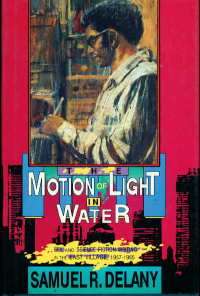The Motion of Light in Water
 Dust-jacket from the first edition | |
| Author | Samuel R. Delany |
|---|---|
| Country | United States |
| Language | English |
| Genre | Autobiography |
| Publisher | Arbor House |
Publication date | 1988 |
| Media type | Print (Hardcover)(Paperback) |
| Pages | 302 |
| ISBN | 0-87795-947-1 |
| OCLC | 16833709 |
The Motion of Light in Water: Sex and Science Fiction Writing in the East Village is an autobiography by science fiction author Samuel R. Delany in which he recounts his experiences as growing up a gay African American, as well as some of his time in an interracial and open marriage with Marilyn Hacker. It describes encounters with Albert Einstein, Bob Dylan, and Stokely Carmichael, a dinner with W. H. Auden, and a phone call to James Baldwin. Hazel Carby called it one of two contemporary autobiographies that are "absolutely central to any consideration of black manhood" (the other being that of Miles Davis).[1] Among many cultural events of the decade that he witnessed, Delany recounts his attendance at the first New York City performance of artist Allan Kaprow's 18 Happenings in 6 Parts, the 1959 performance piece that, for many, marks the end of modernism and the beginning of postmodernism.[2] In section 17.4 of the University of Minnesota Press edition, he describes the event and its venue, and speculates on its artistic significance.[3] The introduction puts an emphasis on the idea of the unreliable narrator; Delany's accounts often contrast his life as it "felt" to ways in which it actually occurred. In the chapter, The Future Is in the Present of the book Cruising Utopia by José Esteban Munoz, Delany's The Motion of Light in the Water serves to explain how the future, as a formed of utopia, can be "glimpsed" in the present through what Delany employed as "the massed bodies" of sexual dissidence.[4]
Awards
- 1989 Hugo Award for Best Non-Fiction Book[5]
Publication history
- 1988 Arbor House 0877959471
- 1989 Plume 0452262321
- 1994 Richard Kasak 156331330
- 2004 Minnesota Press 0816645248
- 2004 InsightOut Books 0965903753
References
- ↑ Hazel V. Carby (2009). Race Men. Harvard University Press. p. 135. ISBN 0674029194.
- ↑ "Many times now Kaprow's piece (today we would call it 'performance art') has been cited by art historians as the (equally arbitrary) transition between the modern and the postmodern in cultural developments" (Delany, Samuel R. (1988), The Motion of Light in Water (1st ed.), New York: Arbor House, p. 110, ISBN 0877959471).
- ↑ Brown, Charles N.; William G. Contento. "The Locus Index to Science Fiction (1984-1998)". Retrieved 2008-01-04.
- ↑ Muñoz, José Esteban (2009). Cruising Utopia The Then and There of Queer Futurity. New York University Press. p. 52.
- ↑ Yarrow, Andrew L. (September 4, 1989). "Sci-Fi Fans Meet to Ponder Genre's Present". The New York Times. Retrieved March 30, 2010.